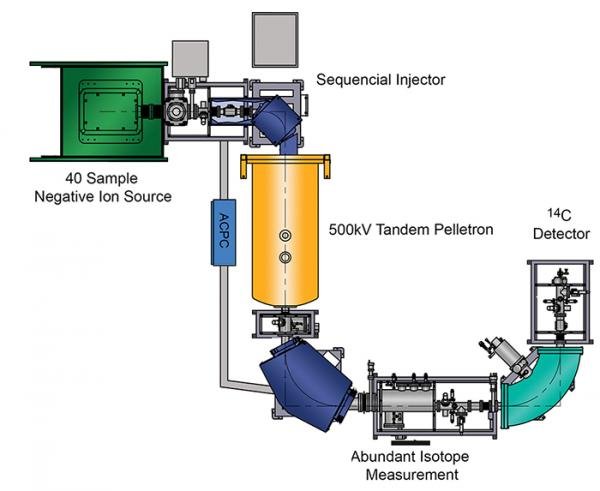Accelerator Mass Spectrometry (AMS) is a specialized technique used in archaeology and other fields to measure the concentration of isotopes, particularly radiocarbon (^14C), in samples. It is an enhanced version of traditional mass spectrometry that allows for the precise measurement of isotopes, particularly those that are present in very low concentrations.
The method
Radiocarbon dating is a fundamental method in archaeology for determining the age of organic materials, such as bone, wood, and charcoal, that were once part of living organisms. This method relies on the decay of radiocarbon isotopes in the sample over time.
Traditional radiocarbon dating techniques involve measuring the decay of radiocarbon isotopes using a method called liquid scintillation counting or proportional gas counting. These methods are effective but have limitations in terms of the amount of sample required and the precision of dating.

AMS revolutionized radiocarbon dating by allowing researchers to measure extremely small amounts of radiocarbon in samples. It is a highly sensitive technique that accelerates ions to high energies before subjecting them to magnetic and electric fields that separate the ions based on their mass and charge. This separation allows for accurate measurement of the isotopic ratios in the sample.
The main advantages of AMS in archaeology are:
Reduced Sample Size: AMS requires much smaller samples than traditional methods, making it possible to date even very small fragments or precious artifacts without causing significant damage.
High Precision: AMS provides greater precision in dating due to its ability to measure smaller amounts of radiocarbon, leading to more accurate age estimates.
Versatility: AMS can be applied to a wider range of sample types, including those that were previously difficult to date accurately.
Fast Turnaround: AMS facilities can process samples more quickly, allowing for faster results compared to traditional methods.
Calibration: AMS data can be combined with calibration curves that account for variations in atmospheric ^14C levels over time, improving the accuracy of the final age estimates.
Contamination Control: The process of preparing samples for AMS often involves thorough cleaning and chemical treatment, which helps minimize potential contamination that could affect the accuracy of the dating.

Overall, Accelerator Mass Spectrometry has become a valuable tool in archaeology and other fields that require precise dating of organic materials. In addition to radiocarbon dating, AMS can be used to analyze isotopes in archaeological and anthropological samples, shedding light on ancient diets, migration patterns, and cultural practices.
































